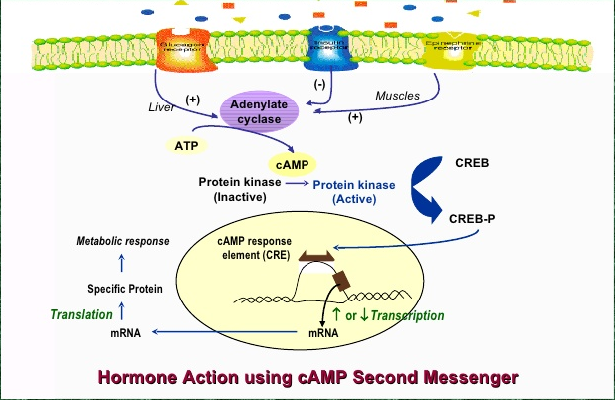
- On the basis of location of the receptors to which they bind and the signals used to mediate their action, hormones are classified into two broad groups;
a. Group I hormones:
-
- Group I hormones bind to the receptors present inside the target cells to form receptor hormone complexes. These hormone-receptor complexes act as intracellular messengers through which the biochemical functions of such hormones are mediated.
- These hormones are lipophilic in nature and are mostly derived from cholesterol (exception T3 and T4).
- Androgens, Estrogen, Glucocorticoids, Calcitriol etc. are few examples.
b. Group II hormones:
-
- These hormones bind to the receptors present on the plasma membrane also called cell surface receptors and stimulate the release of certain molecules, namely second messengers which, in turn, perform the biochemical functions.
- Thus, hormones themselves are the first messengers.
- Group II hormones are further subdivided into three categories based on the chemical nature of the second messengers.
- The second messenger is cAMP. E.g. ACTH, FSH, LH, PTH, Glucagon, Calcitonin etc.
- The second messenger is phosphatidyl-inositol/calcium. E.g. TRH, GnRH, Gastrin, CCK etc.
- The second messenger is unknown. E.g. growth hormone (Somatotropin), Insulin, Oxytocin, Prolactin etc.
Mechanism of action of Group I hormones:
- Since these hormones are lipophilic in nature, they can easily pass across the plasma membrane and bind to the intracellular receptors located either in the cytosol or the nucleus.
- The hormone-receptor complex thus formed now binds to specific regions on the DNA called hormone responsive element (HRE) and causes the increased expression of specific genes.
- The interaction of hormone receptor complex with HRE is believed to promote initiation and, to a lesser extent, elongation and termination of RNA synthesis (transcription).
- Ultimately, it results in the production of specific proteins (translation) in response to hormonal action.
Mechanism of action of Group II hormones:
- These hormones are considered as the first messengers because their functions are carried out through mediatory molecules which are collectively called second messengers. The mechanism of action through a second messenger cAMP, is given below:
a. Action of cAMP:
- cAMP or cyclic Adenosine 3’, 5’ monophosphate is a ubiquitous molecule which consists of adenine, ribose and a phosphate (linked by 3’, 5’ linkage on ribose sugar).
- Majority of polypeptide hormones carry out their biochemical function with cAMP acting as a second messenger.
- Adenylate cyclase is a membrane-bound enzyme that converts ATP to cyclic AMP. Enzyme phosphodiesterase hydrolyzes cAMP to 5’- AMP and makes it inactive.
- The activity of adenylate cyclase is influenced by a series of events occurring at the membrane level that leads to the synthesis of cAMP from ATP.
- This process is mediated by G- proteins, which have the ability to bind to guanine nucleotides.
- Once cAMP is formed, it performs its role in carrying out biochemical responses.
- cAMP activates protein kinase A ,a hetero-tetramer of 2 regulatory subunits (R) and 2 catalytic subunits (C).
- cAMP binds to inactive protein kinase and results in the dissociation of R and C subunits.
- The active subunit (C) catalyzes the phosphorylation of serine and threonine residues in CREB (cAMP response element-binding protein).
- CREB is a cellular transcription factor. Phosphorylated CREB (CREB-P) binds to certain DNA sequences called cAMP response elements (CRE), thereby increasing or decreasing the transcription of the genes, ultimately causing the biochemical response.
- cAMP, however doesn’t act on all protein kinases. For example, Protein kinase C is acted upon by a second messenger, diacylglycerol.

b. Dephosphorylation of proteins:
- Protein phosphatases (a group of enzymes) carry out the hydrolysis and removal of phosphate groups added to CREB proteins by protein kinases once the biochemical response is carried out.
c. Degradation of cAMP:
- When hormone is no more secreted, cAMP undergoes rapid hydrolysis. Enzyme phosphodiesterase hydrolyzes cAMP to 5’- AMP which is inactive.
- Hence, the effect of cAMP will be shortlived if the hormone stimulating adenylate cyclase is removed.
- Caffeine and theophylline (methylxanthine derivatives) can inhibit phosphodiesterases and increase the intracellular level of cAMP.
